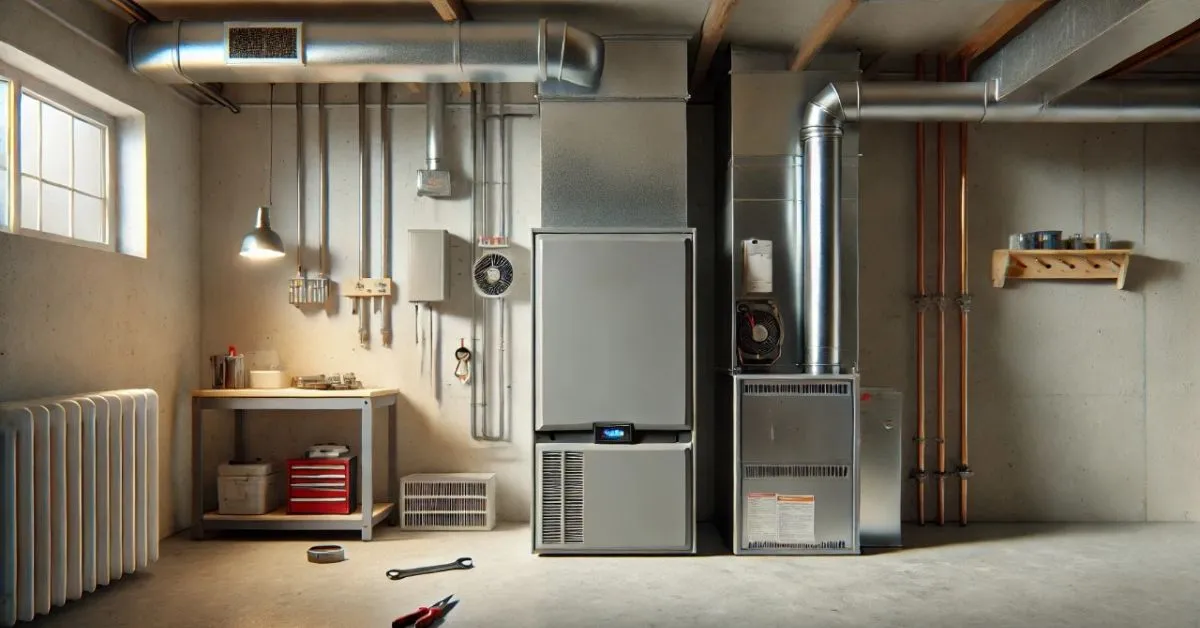Furnaces are essential for maintaining comfortable indoor temperatures during colder months. Many homeowners are unfamiliar with how these heating systems operate despite their widespread use. Understanding the inner workings of a furnace helps diagnose potential issues and empowers you to make informed decisions when selecting, maintaining, or replacing your heating system.
Benefits of Understanding Furnace Operations
- Problem Diagnosis: Recognize and troubleshoot issues promptly.
- Informed Contractor Selection: Choose HVAC contractors committed to proper installation and maintenance.
- Equipment Selection: Evaluate different furnace types to select the best fit for your home.
- Maintenance Awareness: Stay proactive in scheduling regular maintenance to extend your furnace’s lifespan.
The Heating Process: How Does a Furnace Work?
While furnace technology has evolved, the fundamental principles of heating remain consistent across different models. The heating cycle begins with the thermostat and involves several key components working in harmony.
The Role of the Thermostat
The thermostat monitors your home’s temperature and compares it to your desired setting. When it detects a temperature drop below the set point, it signals the furnace to start heating.
Ignition Systems: Old vs. Modern Furnaces
Older Systems:
- Pilot Light: A continuously lit pilot light ignites the burners.
- Direct Ignition: Similar to a car’s spark plug, it ignites the fuel directly.
Modern Systems:
- Hot Surface Ignition: Uses an electrically heated element, akin to a car’s cigarette lighter, to ignite the burners.
- Electric Furnaces: Utilize heating coils that warm up when electricity passes through them.
Combustion and Heat Exchange
- Burners Ignite: Fuel (gas, propane, or oil) is ignited in the combustion chamber.
- Heat Exchanger: The combustion gases heat the exchanger’s walls, transferring heat to the air without mixing combustion gases with the home’s air supply.
- Inducer Motor: Modern furnaces use an inducer motor to efficiently draw combustion gases through the heat exchanger.
Air Circulation
- Blower Motor Activation: The blower motor starts after the heat exchanger reaches the optimal temperature.
- Warm Air Distribution: The blower pushes air over the heat exchanger, warming it before sending it through the ductwork into your home.
- Return Air: Cooler air from rooms is pulled back into the furnace to be reheated.
Exhaust and Venting
- Flue or Vent Pipe: Excess combustion gases are vented outside to prevent harmful buildup.
- Efficiency Impact: High-efficiency furnaces have advanced venting systems that reduce heat loss.
Safety Measures in Modern Furnaces
Modern furnaces incorporate several safety features to protect homeowners and enhance system efficiency.
- Flame Sensor: Detects if the burner is lit and shuts off the gas if there is no flame.
- Limit Switches: Monitor temperatures to prevent overheating.
- Rollout Switches: Shut down the furnace if combustion gases escape the heat exchanger.
- Pressure Switches: Ensure the inducer motor is functioning correctly before ignition.
Critical Components of a Furnace
Understanding the main components helps in recognizing their roles and importance.
Blower Motor
- Function: Circulates air through the heat exchanger and into the home.
- Dual Role: Works with both heating and cooling systems.
Heat Exchanger
- Function: Transfers heat from combustion gases to the air without mixing the two.
- Importance: A cracked heat exchanger can lead to dangerous carbon monoxide leaks.
Combustion Chamber
- Function: Houses the burners where fuel combustion occurs.
- Maintenance: Requires regular cleaning to prevent soot buildup.
Air Filters
- Function: Remove dust and debris from the air entering the furnace.
- Maintenance: Regular replacement is essential for airflow and system efficiency.
Variations in Furnace Models
Furnaces differ in operation modes and energy efficiency.
Single-Stage Furnaces
- Operation: On or off at total capacity.
- Efficiency: Less efficient due to constant cycling and temperature fluctuations.
Two-Stage Furnaces
- Operation: Two settings—low and high heat output.
- Benefits: Improved efficiency, consistent temperatures, and reduced energy consumption.
Variable-Speed Furnaces
- Operation: Adjusts blower speed and heat output in multiple increments.
- Benefits: Optimal energy efficiency, precise temperature control, and enhanced comfort.
Note: Advanced furnaces require compatible thermostats for proper functionality.
Energy Sources and Their Differences
The type of fuel a furnace uses affects its components and safety measures.
Gas Furnaces
- Fuel: Natural gas or propane.
- Components: Include gas valves, burners, and ignition systems specific to gas combustion.
- Safety: Equipped with sensors and switches to prevent gas leaks and ensure safe operation.
Electric Furnaces
- Fuel: Electricity.
- Components: Heating elements instead of burners.
- Safety: Include thermal cutoffs and fusible links to prevent overheating.
Oil Furnaces
- Fuel: Heating oil.
- Components: Oil burner that atomizes and ignites oil.
- Maintenance: Requires regular cleaning due to soot and residue buildup.
Measuring Furnace Efficiency
Efficiency ratings help determine how well a furnace converts fuel into heat.
AFUE (Annual Fuel Utilization Efficiency)
- Definition: Percentage of fuel converted into usable heat over a heating season.
- Standard Efficiency: Around 80% AFUE.
- High Efficiency: 90% AFUE or higher, with top models reaching up to 98%.
Example: An 80% AFUE furnace uses $0.80 of every dollar for heating, while $0.20 is lost to exhaust.
HSPF (Heating Seasonal Performance Factor)
- Used For: Electric heat pumps.
- Measurement: Efficiency of heat pumps over a heating season.
- Modern Ratings: Systems now often exceed HSPF 8.2, indicating higher efficiency.
Maintenance, Repair, and Lifespan
Proper care extends the life and efficiency of a furnace.
Expected Lifespan
- Average: 15–20 years with proper maintenance.
- Factors Affecting Lifespan:
- Maintenance Frequency: Annual inspections and tune-ups are crucial.
- Filter Changes: Regularly replacing filters prevents strain on the system.
- Installation Quality: Proper installation prevents future issues.
Importance of Regular Maintenance
- Efficiency: Maintains optimal performance and lowers energy bills.
- Safety: Identifies potential hazards like gas leaks or carbon monoxide risks.
- Longevity: Extends the furnace’s operational life.
Conclusion
Understanding how a furnace works provides valuable insights into maintaining a comfortable and safe home environment. With this knowledge, you can make informed decisions about furnace selection, maintenance practices, and when to seek professional assistance. Regular maintenance and proper care ensure that your furnace operates efficiently, providing warmth and comfort for many years.
Related: Furnace Installation Costs: What to Know Before You Install
Additional Resources
- Choosing the Right HVAC Contractor: Tips on selecting qualified professionals.
- Energy Efficiency Guidelines: Understanding ratings and how to improve efficiency.
- Home Heating Safety: Best practices to prevent hazards.

